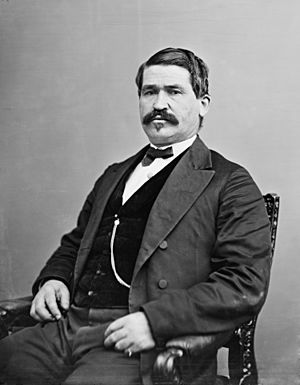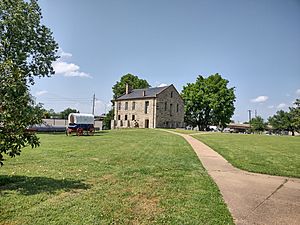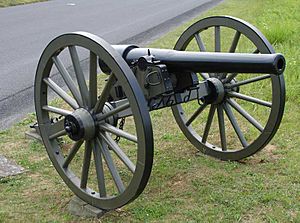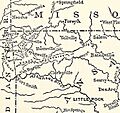Battle of Van Buren facts for kids
Quick facts for kids Battle of Van Buren |
|||||||
|---|---|---|---|---|---|---|---|
| Part of the Trans-Mississippi Theater of the American Civil War |
|||||||
|
|||||||
| Belligerents | |||||||
| Commanders and leaders | |||||||
| James G. Blunt Francis J. Herron |
Theophilus Holmes Thomas C. Hindman |
||||||
| Units involved | |||||||
| Army of the Frontier | First Corps, Army of the Trans-Mississippi | ||||||
| Strength | |||||||
| 8,000 | 5,000 | ||||||
| Casualties and losses | |||||||
| 1 killed and 5 wounded or 2 killed and 6 wounded | Unknown, roughly 12 killed, 24 wounded, and several hundred captured | ||||||
The Battle of Van Buren was a fight during the American Civil War on December 28, 1862. It happened in Van Buren, Arkansas. Just before this battle, Union (Northern) forces had beaten Confederate (Southern) troops at the Battle of Prairie Grove.
After their victory, Union generals James G. Blunt and Francis J. Herron planned a quick attack on Confederate spots in Van Buren and Fort Smith. The Confederate commander, Thomas C. Hindman, had already started moving most of his soldiers away because they were sick, lacked supplies, and many had left. On December 27, Union troops began their march. The next morning, December 28, they surprised a Confederate cavalry (horseback soldiers) unit near Van Buren. The Confederate cavalry quickly ran away to Van Buren, and the Union troops soon took over the town.
The Union soldiers chased the Confederates and captured three steamboats on the Arkansas River. They also took many supplies and some Confederate soldiers in Van Buren. Across the river in Fort Smith, the Confederates destroyed their own supplies and burned two steamboats that were stuck. There was also a cannon fight at Van Buren. After dark, a small fight happened downriver. After the battle, Hindman moved his men to Little Rock. The Union forces then left Van Buren because it was too hard to get supplies to them across the Boston Mountains. The battles of Prairie Grove and Van Buren greatly weakened the Confederate army in this area.
Contents
Why the Battle Happened
After Abraham Lincoln became President of the United States in 1860, some southern states thought about leaving the United States. In Arkansas, many people at first did not want to leave. But after Confederate troops attacked Fort Sumter on April 12, 1861, more people in Arkansas wanted to secede. Arkansas then voted to leave the Union on May 6 and joined the Confederate States of America.
In early 1862, Confederate Major General Earl Van Dorn gathered an army in Arkansas. He moved north to fight the Union army, but he was defeated at the Battle of Pea Ridge in March. After this loss, Van Dorn moved most of his soldiers and supplies from Arkansas to the east, leaving the state with very few troops.
In May, Major General Thomas C. Hindman took charge of Confederate forces in Arkansas. His job was to rebuild the army there. Hindman did a good job of making the Confederate army stronger. But his ways were not always popular. He was later replaced by Major General Theophilus Holmes in August.
Hindman still led soldiers under Holmes. He moved his troops into northern Arkansas and southwestern Missouri. His group was called the First Corps of the Army of the Trans-Mississippi. In September, Holmes called Hindman back to Little Rock, but his troops stayed where they were.
Union generals James G. Blunt and John Schofield then combined their troops to form the Army of the Frontier. Hindman returned to lead his men in October. Schofield later pulled most of his troops back to Springfield, Missouri, leaving only Blunt's group in Arkansas. Hindman decided to attack while the Union forces were divided. After some fighting with Blunt's cavalry, Hindman began moving north across the Boston Mountains on December 3. These mountains were very rough and covered in thick brush. Union General Francis J. Herron began a long march from Springfield on December 4 to help Blunt.
On December 6, Hindman learned that Herron's troops were arriving to help Blunt. So, Hindman changed his plan. He decided to attack Herron first at Prairie Grove on December 7, and then attack Blunt. But instead of attacking, Hindman waited for Herron to attack him. Hindman's men fought Herron's until Blunt's soldiers arrived. This helped the Union side win the battle. Hindman knew his army was tired and low on food and ammunition. So, he began to retreat to Van Buren the night after the battle.
It was hard to find food for horses near Van Buren. So, Hindman sent some of his cavalry, led by General John S. Marmaduke, about 100 miles south. While in Van Buren, Hindman's army also suffered from many diseases and soldiers leaving the army. Van Buren was on the north side of the Arkansas River. Fort Smith was to the southwest, on the south side of the river. The Arkansas River was very important for moving supplies and people. The area around the river was also good for growing food for the Confederate army. North of the river were the Boston Mountains.
Getting Ready for Battle

Hindman decided it was not practical to keep most of his army north of the Arkansas River in Van Buren. So, he moved most of his men south of the river to Fort Smith. Hindman left only one group of foot soldiers and some cannons in Van Buren. Some Texas cavalry, led by Lieutenant Colonel Richard Phillip Crump, were placed at Dripping Springs. This spot was about 8 miles north of Van Buren. Their job was to watch the roads coming from the north.
On December 21, General Holmes visited the Van Buren area. He told Hindman to move his troops to Lewisburg, where they could get supplies more easily by river. Hindman began moving sick soldiers and unneeded supplies out of Fort Smith on December 23. The main Confederate force started leaving on December 26. They were still slowly loading supplies onto river boats on December 28. On that day, there were about 5,000 Confederates in the area, mostly south of the Arkansas River.
After resting for three days after the Prairie Grove battle, Union generals Herron and Blunt decided to move south to attack Hindman. They had 8,000 men. Their move was delayed by a heavy snowstorm. But the weather cleared, and on December 25, the two Union officers decided to move forward. They spread false information on December 26, saying they were going to Huntsville. But the next morning, they began their real march with 8,000 men and thirty cannons. The Union troops marched in cold weather, and some areas were covered in snow. Cannons and wagons had trouble moving through thick mud. Blunt and Herron's groups traveled separately, taking different paths.
The Fight at Van Buren
On the morning of December 28, Blunt's cavalry was at the front of his force. The cavalry stopped at Oliver's Store for Blunt's foot soldiers and cannons to catch up. Herron's cavalry joined Blunt's at the store. Herron and Blunt talked to local Union supporters to find out where Crump's camp and lookouts were. Herron's foot soldiers had not arrived yet, but he had 3,000 cavalrymen there. Blunt was the higher-ranking officer, so he took overall command.
The Union cavalry, with the 2nd Kansas Cavalry Regiment in the lead, headed south. About 2 miles from the store, and 8 miles from Dripping Springs, they met some of Crump's lookouts. Blunt ordered the cavalry to push all the way to the Arkansas River. Crump heard the gunfire and took two companies to see what was happening. When he met the 2nd Kansas Cavalry about 3 miles north of his camp, Crump's group ran back to their camp. By the time Crump got back to prepare his surprised men, the Union cavalry was almost on them.
Three Union groups — the 2nd Kansas Cavalry, the 6th Kansas Cavalry Regiment, and the 3rd Wisconsin Cavalry Regiment — got ready around 10:00 AM. Colonel William F. Cloud brought up two small cannons called mountain howitzers. After six shots from the cannons, the Union cavalry charged. Crump's Texans quickly ran away. Crump tried to gather his men three times, but the Union cavalry chased them all the way to Van Buren in just one hour.
The Union cavalry, led by Cloud, stopped at a hill overlooking the Arkansas River. This allowed Blunt and Herron to catch up. When the Union troops charged down the hill, Herron sent part of the 1st Missouri Cavalry Regiment to the east. This was to block a road the Confederates might use to escape. By the time Union troops entered Van Buren, most Confederates had already gotten on steamboats on the Arkansas River or were using a ferry to cross the river. Some sick soldiers and men from the supply departments were captured by the Union soldiers in Van Buren. The steamboats leaving down the river had been loaded with some of Hindman's supplies. To escape faster, some of the cargo was thrown overboard.
Scouts told Blunt that there was a bend in the river about 2 miles below Van Buren. Cloud was sent there with a group of soldiers and two cannons to try to stop the steamboats. The last ship, the Frederick Notrebe, was caught by the 2nd Kansas Cavalry. The Kansans fired at the ship, forcing its crew to give up. Two more steamboats, the Rose Douglass and Key West, continued downriver. The Rose Douglass was fired on and then boarded by Union cavalry. The Key West gave up at Strain's Landing, about 6 or 10 miles below Van Buren. This ship had stopped at the landing for some reason and was then caught by Union cavalry.
One of the Union mountain howitzers fired at the ferry in Van Buren. It killed the horse pulling the ferry, but the soldiers on board managed to escape across the river. Union troops also captured the steamboat Violet in Van Buren. They took three ammunition wagons and twenty-seven supply wagons during the chase of the other steamboats. The Rose Douglass, Key West, and Frederick Notrebe were brought back to Van Buren by early afternoon.
While Blunt and Herron talked about attacking across the river to Fort Smith, the Confederates brought up troops on the other side of the river. In Fort Smith, Hindman learned of the Union attack around 10:00 AM. He ordered a group of soldiers to go to Fort Smith and another group to Strain's Landing. By the time these soldiers reached Fort Smith, Union troops had already held Van Buren for about two and a half hours.
The Confederates fired cannons at Van Buren for two hours. Herron thought this was wrong because many civilians were in the town, as well as Union troops. Union cannons were brought up to support their soldiers. The 1st Kansas Battery set up on the hill overlooking the river and fired at the Confederate position around 4:00 PM. They used four 10-pounder Parrott rifles. The Confederates had not expected Union cannons. When Union shots landed among their soldiers, they were ordered to retreat. The Union cannons did not notice the retreat and kept firing. The Union foot soldiers finished their march to Van Buren around 7:00 PM.
An hour after dark, Cloud sent the 2nd Kansas Cavalry and 1st Kansas Battery back down to Strain's Landing. He had seen a Confederate camp there earlier. When the Union units arrived, the position was held by Confederate cannons and some foot soldiers. The Confederate cannons fired at the Union positions until the Kansas cannons drove them away. Two Confederate boats had been trapped upstream by the Union attack, and they were burned. Hindman had ordered Fort Smith to be abandoned and burned if needed. After the Union attack on Van Buren, the Confederates panicked and burned docks and warehouses in Fort Smith.
After the Battle

Hindman was sure he could not hold Fort Smith against a Union attack. Since everything important was destroyed, he decided to retreat. He left only a few groups of soldiers to bother the Union troops. On the morning of December 29, Blunt sent a scouting party across the river. They found that only 600 sick and wounded Confederates were left at Fort Smith. A Union patrol was sent to burn the two boats upstream, but they found that the Confederates had already done it.
After taking things from the town the night after the battle, the Union forces held a military parade that day to impress the local people. The Union troops also freed several hundred slaves. Supplies that could be moved north were taken. Anything they could not carry, including a lot of corn, the ferry, and the steamboats, was burned. Blunt, Herron, and Colonel Daniel Huston Jr. briefly crossed the Arkansas River with fourteen men. They seemed to want to be the first Union officers to cross it. Union troops found Confederate messages in a telegraph office, which gave them important military information. Overall, the Confederates lost 25,000 bushels of grain, 42 wagons, and many pieces of equipment and ammunition.
Blunt could not keep a supply line going over the Boston Mountains. So, he decided to leave that day. Herron led the retreat with the foot soldiers and cannons, leaving after sunset. Schofield caught up with the group during Herron's retreat. But he let Blunt stay in command even though Schofield was a higher-ranking officer. Blunt left Van Buren with the cavalry on December 30. The raid was over by the next day, when the Union troops arrived at Rhea's Mill.
Union losses were one man killed and five wounded, or two killed and six wounded. Confederate losses are not fully known. But it is thought that about a dozen were killed, two dozen wounded, and a few hundred were captured and then released. By January 8, 1863, only parts of two Confederate cavalry groups and one group of foot soldiers remained at Fort Smith. Holmes ordered Hindman to leave the Fort Smith area. The Confederates spent the start of 1863 retreating to Little Rock. Union troops captured Fort Smith later, on September 1, 1863.
The battles at Prairie Grove and Van Buren greatly weakened the Confederate army in the region. After these battles, there were no more large-scale army fights in the area. However, cavalry raids and small group fighting continued.
Images for kids



